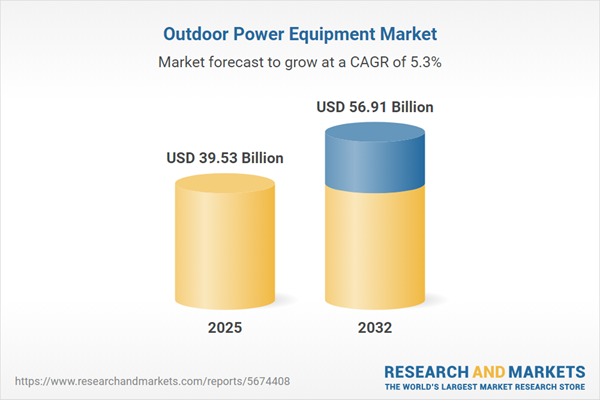Speak directly to the analyst to clarify any post sales queries you may have.
The outdoor power equipment market continues to transform, shaped by innovation, shifting user demands, and the advancement of sustainability practices. Industry leaders must anticipate and address complex regulatory, technological, and procurement trends to maintain a competitive edge in a rapidly evolving marketplace.
Market Snapshot: Outdoor Power Equipment Market Overview
The Outdoor Power Equipment Market grew from USD 37.52 billion in 2024 to USD 39.53 billion in 2025. It is projected to expand at a CAGR of 5.34%, achieving a value of USD 56.91 billion by 2032.
This growth is propelled by rising performance expectations, intensified regulatory focus, and rapid electrification, driving transformation across global supply chains.Scope & Segmentation
This report offers strategic insight into the outdoor power equipment sector, outlining the core categories and regional dynamics affecting enterprise decision-making:
- Product Types: Generators (portable and standby), handheld equipment (chainsaws, leaf blowers, string trimmers), lawn mowers (push, riding), tillers & cultivators (front tine, rear tine).
- Power Sources: Battery (lead acid, lithium ion), electric, gas.
- End Users: Commercial, industrial, residential.
- Distribution Channels: Dealer & distributor (national, regional), hypermarket & supermarket, online retail (direct e-commerce, marketplaces), specialty stores.
- Regions: Americas (United States, Canada, Mexico, Brazil, Argentina, Chile, Colombia, Peru), Europe, Middle East & Africa (United Kingdom, Germany, France, Russia, Italy, Spain, Netherlands, Sweden, Poland, Switzerland, United Arab Emirates, Saudi Arabia, Qatar, Turkey, Israel, South Africa, Nigeria, Egypt, Kenya), Asia-Pacific (China, India, Japan, Australia, South Korea, Indonesia, Thailand, Malaysia, Singapore, Taiwan).
- Key Companies: Andreas STIHL AG & Co. KG, Husqvarna AB, Honda Motor Co. Ltd., The Toro Company, MTD Holdings Inc., Deere & Company, Ariens Company, Kawasaki Heavy Industries Ltd., Briggs & Stratton LLC, Echo Incorporated.
Key Takeaways for Senior Leaders
- Electrification and digital technology are driving new product development and shaping user expectations within the outdoor power equipment market.
- As sustainability pressures intensify, manufacturers are incorporating eco-friendly materials and circular design principles from sourcing to end-of-life.
- Emerging regional differences require adaptive go-to-market strategies—ranging from supporting high-emission standards in mature markets to prioritizing affordability and durability elsewhere.
- Modular designs paired with interoperable battery platforms are gaining traction, offering greater flexibility for end users and simplifying product maintenance.
- Strategic alliances, including joint ventures and acquisitions in battery management, IoT solutions, and lightweight materials, are reshaping the competitive landscape.
- Companies investing in predictive maintenance and after-sales connectivity are building recurring revenue streams and fostering customer loyalty across segments.
Tariff Impact on Global Supply Chains
The implementation of United States tariffs in 2025 has significantly influenced sourcing strategies, cost structures, and procurement partnerships throughout the sector. Organizations are adopting nearshoring, supplier diversification, and increased regional collaboration to mitigate exposure and align with trade dynamics. This realignment is also fueling renewed investment in domestic component manufacturing and R&D initiatives, strengthening the sector’s resilience despite global policy shifts.
Methodology & Data Sources
This market research leverages a mixed-method approach, combining qualitative interviews with industry experts and primary surveys with end users. Secondary data is sourced from regulatory filings, patent registries, and authoritative industry journals. Rigorous data validation and harmonization ensure the integrity and analytical depth of the findings presented.
Why This Report Matters: Actionable Value for Decision-Makers
- Enables proactive positioning by clarifying innovation drivers, regulatory trends, and operational risks across core product categories and regions.
- Facilitates targeted investment and partnership strategies by mapping emerging technology adoption and competitive dynamics within the outdoor power equipment market.
Conclusion
Senior executives benefit from actionable insights into evolving demand drivers, technology trends, and global regulatory priorities. Leveraging these findings supports strategic decision-making and long-term value creation across commercial, industrial, and residential segments.
Additional Product Information:
- Purchase of this report includes 1 year online access with quarterly updates.
- This report can be updated on request. Please contact our Customer Experience team using the Ask a Question widget on our website.
Table of Contents
3. Executive Summary
4. Market Overview
7. Cumulative Impact of Artificial Intelligence 2025
Companies Mentioned
The companies profiled in this Outdoor Power Equipment market report include:- Andreas STIHL AG & Co. KG
- Husqvarna AB
- Honda Motor Co., Ltd.
- The Toro Company
- MTD Holdings, Inc.
- Deere & Company
- Ariens Company
- Kawasaki Heavy Industries, Ltd.
- Briggs & Stratton LLC
- Echo Incorporated
Table Information
| Report Attribute | Details |
|---|---|
| No. of Pages | 186 |
| Published | November 2025 |
| Forecast Period | 2025 - 2032 |
| Estimated Market Value ( USD | $ 39.53 Billion |
| Forecasted Market Value ( USD | $ 56.91 Billion |
| Compound Annual Growth Rate | 5.3% |
| Regions Covered | Global |
| No. of Companies Mentioned | 11 |









